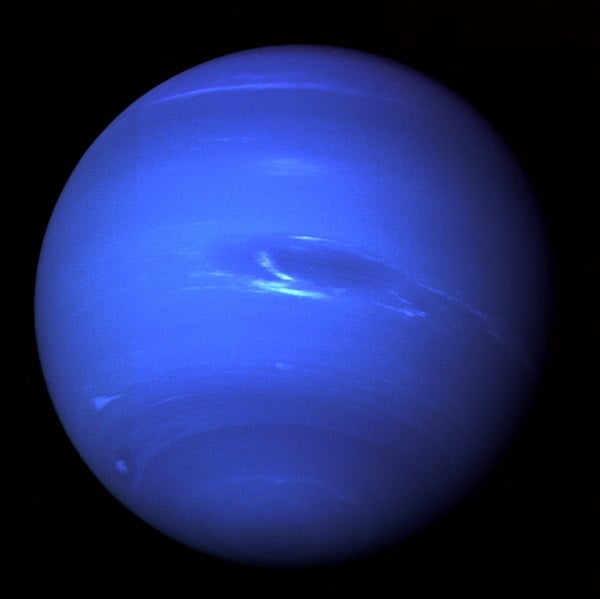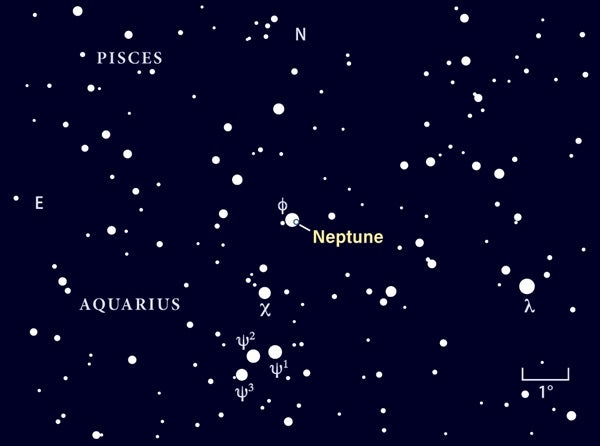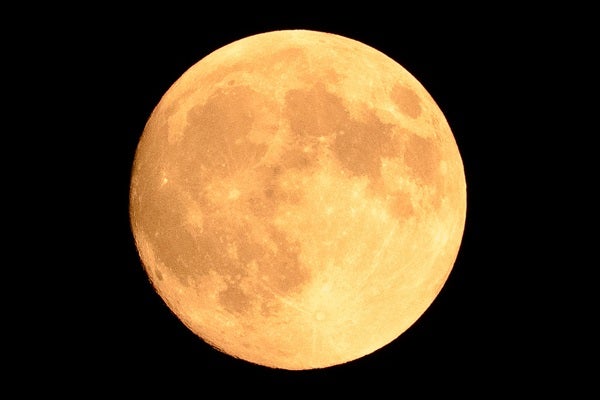The variable star Algol in Perseus reaches minimum brightness at 2:05 a.m. EDT tomorrow morning. Observers on the East Coast who start watching around midevening can see the star’s brightness diminish by 70 percent over the course of about five hours. Those in western North America will see Algol brighten noticeably from late evening until dawn starts to paint the sky, when the star passes nearly overhead. This eclipsing binary system runs through a cycle from minimum (magnitude 3.4) to maximum (magnitude 2.1) and back every 2.87 days.
Saturday, September 7
The waxing gibbous Moon points the way to Saturn this evening. The dazzling Moon lies due south as darkness falls while the magnitude 0.4 planet appears 6° to its left. They inch slightly closer by the time they reach the western horizon after midnight. They are in conjunction with each other after dawn on the 8th, and by evening twilight tomorrow, the planet stands 6° to the Moon’s right. It’s worth checking out Saturn through a telescope, particularly later this week when it’s farther from the Moon’s glare. Even the smallest scope shows the planet’s 17″-diameter disk and its magnificent rings, which span 40″ and tilt 25° to our line of sight.
Sunday, September 8
Jupiter continues to dominate the evening sky from its perch in southern Ophiuchus the Serpent-bearer. The giant planet shines at magnitude –2.2 and stands nearly 25° high in the south-southwest as twilight fades to darkness. When viewed through a telescope, the planet shows a 38″-diameter disk and striking details in its massive atmosphere.
Neptune reaches opposition and peak visibility tonight (officially at 3 a.m. EDT on the 10th). Because it lies opposite the Sun in our sky, it rises at sunset and appears highest in the south around 1 a.m. local daylight time. But you can start searching for it by 10 p.m., when it stands nearly one-third of the way from the southeastern horizon to the zenith. Neptune glows at magnitude 7.8, bright enough to spot through binoculars if you know where to look. The trick is to find the 4th-magnitude star Phi (φ) Aquarii, which lies about 15° (two binocular fields) east-southeast of Aquarius’ distinctive Water Jar asterism. At opposition, Neptune appears just 0.1° west of Phi. When viewed through a telescope, Neptune shows a blue-gray disk measuring 2.4″ across.
Tuesday, September 10
Although September is typically a slow month for meteors, the International Meteor Organization (IMO) has identified a relatively new shower called the September Epsilon Perseids. Observers witnessed an unexpected flurry of “shooting stars” radiating from the constellation Perseus in both 2008 and 2013. In other years, the rate topped out at five meteors per hour. The shower peaks this morning, with the best views coming after the waxing gibbous Moon sets around 3 a.m. local daylight time and before the start of morning twilight some two hours later. The meteors appear to radiate from the constellation Perseus the Hero, which climbs highest in the sky around 5 a.m.
Wednesday, September 11
If you look overhead as darkness falls anytime this week, your eyes will fall on the brilliant star Vega in the constellation Lyra the Harp. At magnitude 0.0, Vega is the brightest member of the prominent Summer Triangle asterism. The triangle’s second-brightest star, magnitude 0.8 Altair in Aquila the Eagle, lies some 35° southeast of Vega. The asterism’s dimmest member, magnitude 1.3 Deneb in Cygnus the Swan, stands about 25° east-northeast of Vega. Deneb trails Vega by about two hours and passes through the zenith at approximately 10:30 p.m. local daylight time.
Thursday, September 12
Observers of the outer solar system can get good views of Uranus during the late evening hours. The ice giant planet rises around 9 p.m. local daylight time and climbs more than 30° high in the east by midnight. It reaches its peak some 60° above the southern horizon around 4 a.m. Uranus glows at magnitude 5.7 against the backdrop of southern Aries the Ram. Use binoculars to find the planet 2.3° south of the similarly bright star 19 Arietis. A telescope reveals Uranus’ blue-green disk, which spans 3.7″.
Full Moon arrives at 12:33 a.m. EDT tomorrow morning (9:33 p.m. PDT this evening), so our satellite looks completely illuminated all night. Luna rises in the east shortly after the Sun sets and peaks in the south around 1 a.m. local daylight time. The Moon lies among the dim background stars of eastern Aquarius, due south of the Great Square of Pegasus. As the Full Moon closest to the autumnal equinox, this is also the Harvest Moon. In early autumn, the Full Moon rises about half an hour later each night compared with a normal lag close to 50 minutes. The added early evening illumination supposedly helps farmers bringing in their crops.
The Moon also reaches apogee, the farthest point in its orbit around Earth, today. At 9:32 a.m. EDT, it lies 252,511 miles (406,377 kilometers) from Earth’s center.
Saturday, September 14
The constellations Ursa Major the Great Bear and Cassiopeia the Queen lie on opposite sides of the North Celestial Pole, so they pivot around the North Star (Polaris) throughout the course of the night and the year. In the first half of September, these two constellations appear equally high as darkness falls. You can find Ursa Major and its prominent asterism, the Big Dipper, about 30° above the northwestern horizon. Cassiopeia’s familiar W-shape, which currently lies on its side, appears the same height above the northeastern horizon. As the night progresses, Cassiopeia climbs above Polaris while the Big Dipper swings below it.
Sunday, September 15
The dwarf planet Ceres reached opposition in May, but it remains a tempting target in the evening sky thanks to its proximity to the 1st-magnitude star Antares in Scorpius the Scorpion. Even better, magnitude 9.0 Ceres currently lies against a star-poor dust lane in the otherwise rich Milky Way background. This evening, Ceres stands 2.9° due north of Antares, and the nearest star that outshines the dwarf planet lies 1° away. Identifying the solar system object from the suburbs should be easy through a small telescope, and those blessed with dark skies should be able to spot it through binoculars.












